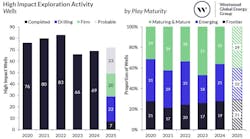Rising US onshore drilling costs are making deepwater E&P more competitive, according to a recent report from Westwood Energy.
Data from the Westwood’s Energent team in Houston indicates that consumption of sand for hydraulic fracturing in the onshore US market hit new highs of over 30 billion lbs (13.6 billion kg) in 2Q 2017, topping the previous peak in 2014, despite only half the number of land rigs working. The US completions market is running in overdrive, the report said.
Onshore US contractors are scrambling to reactivate pressure pumping equipment, assemble crews, and open new sand mines in order to keep up with demand. Insights from Westwood’s Energent team suggest that the market is expecting “double-digit” price increases in 2018. This is expected to average circa 15%. But in some segments, such as proppant, reported price inflation is currently significantly higher than this.
Offshore, the market is also recovering. However, pricing pressure is absent. The industry simply built up too much capacity for the expected level of activity, leading to an oversupply of rigs, construction vessels, and support vessels. This is good news for E&P companies that can now take advantage of lower pricing when sanctioning new developments.
Activity levels are certainly showing encouraging trends, Westwood said. A total of 17 FPS units were ordered in 2017 (compared with zero orders in 2016), and a further 19 units are expected to be ordered this year.
E&P companies are starting to report that some deepwater projects have more favorable project economics than shale. One example was cited by Hess Corp. in recent weeks, which indicated that the Liza Phase 1 project in Guyana required circa $35/bbl in order to break even, while a comparable onshore project in the Delaware basin required $45/bbl to break even. Guyana has proven to be a huge success for ExxonMobil and its partners, with total recoverable resources now estimated at over 3.2 Bboe. A second FPSO for Liza, with a production capacity of up to 200 kbbl/d, is expected to be ordered in 2019.
Looking forward, Westwood is tracking 39 FPS units currently under construction, and has identified nearly 100 further FPS deployment prospects in the coming years. The firm said that this data was a source of “cautious optimism” for the offshore sector in 2018, and an opportune moment for E&P companies to be sanctioning projects.
Aker BP has the approval of Norway’s Petroleum Safety Authority for a drilling program at the Ivar Aasen field in the North Sea. This covers use of the jackupMaersk Interceptor for drilling and completion of two water injection wells (16/1-D-6 and 16/1-D-7). Drilling should get under way this month. (Courtesy Maersk Drilling)
Lundin outlines 2018 drilling goals
Lundin Norway expects to spend $115 million this year on exploration drilling in the Norwegian sector.
The line-up includes four wells (as partner) in the southern Barents Sea. One will be on the Svanefjell prospect in license PL659; another on Shenzhou in PL722; and two in the southeastern Barents area on permits awarded under Norway’s 23rd licensing round.
One of these wells will target the deeper horizons of the Korpfjell prospect in PL859, and the other the shallow horizons of Gjøkåsen in PL859.
Elsewhere, Lundin plans to participate in drilling of the Lille Prinsen prospect in PL167 in the Utsira High region of the North Sea; on Frosk in PL340 in the Alvheim area (currently drilling); on Rungne in PL825; and on the Mandal High prospect in PL860.
The company’s $135-million appraisal drilling line-up is as follows: two operated wells in the Utsira High area, comprising one on the Luno II discovery, where a success would lead to development planning; and one horizontal appraisal well and testing at Rolvsnes, which could de-risk the potential in the larger basement high area.
Both structures Luno II and Rolvsnes are potential subsea tiebacks to the company’s Edvard Grieg production complex.
In addition, Lundin will commission an extended test of the Alta oil discovery in the southern Barents Sea, which involves drilling a horizontal production well and producing to a tanker for up to two months, the aims being to reduce uncertainty around the recovery mechanism and provide the basis for development studies.
The 2018 appraisal budget also includes expenditure on front-end engineering design and PDO studies for Johan Sverdrup Phase 2 in the North Sea.
First-phase SNE oil project offshore Senegal to target 240 MMbbl
Cairn Energy says the partners in the deepwater SNE oil field offshore Senegal are close to concluding appraisal and concept select definition for a first-phase development.
They hope to have secured government approval for their exploitation plan by the end of this year and are targeting first oil in 2021-2023. The plan will cover development of the entire SNE resource base, estimated at 563 MMbbl of oil.
Under the first phase, the partners expect to drill up to 25 wells, targeting around 240 MMbbl, mainly from the S500 lower reservoir with an initial target plateau range of 75-125,000 b/d.
Elsewhere, Cairn expects exploration drilling to start next year on its two licenses in the Sureste basin offshore Mexico. Both were awarded last year – one is operated, the other non-operated.
Across the waters of northwest Europe, the company expects to participate in up to 10 exploratory wells this year, targeting up to 1.5 Bboe from a variety of play types, including the Barents Sea. Operator Wintershall should submit its development plans for the Nova (ex-Skarfjell) field in the northeast of the Norwegian North Sea before mid-year.
Cairn, which has a 20%, anticipates first oil in 2021 and plateau production later on of 50,000 b/d.
Development calls for two subsea templates tied back to the ENGIE-operated Gjøa platform for processing and export. Gjøa will also provide lift gas to the field and water injection for pressure support.





